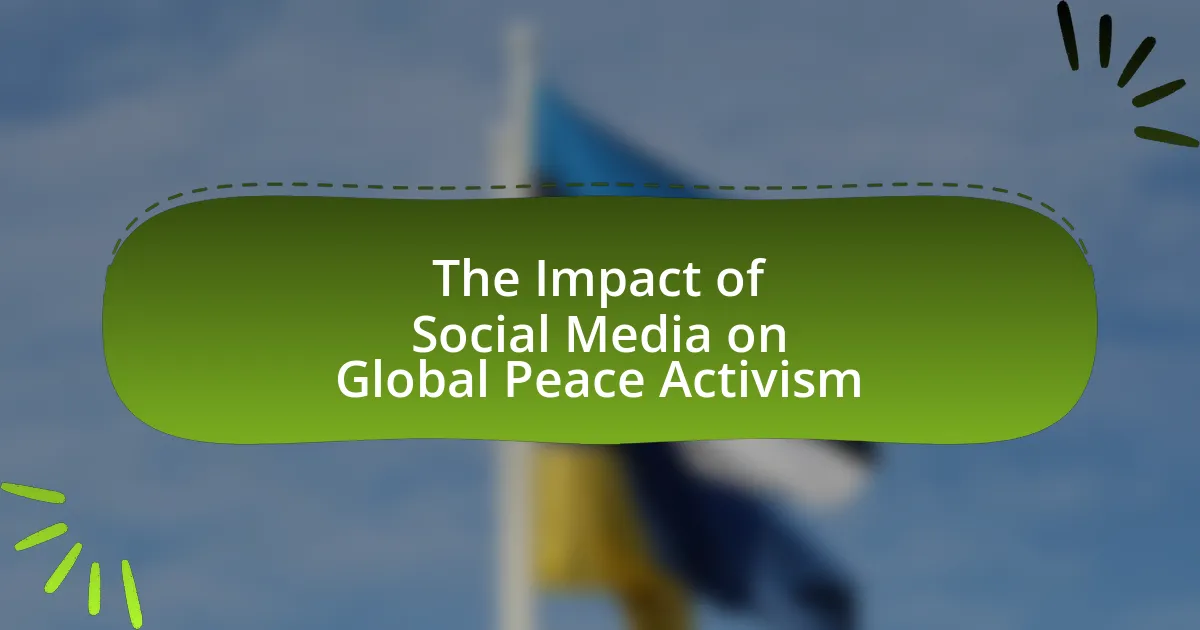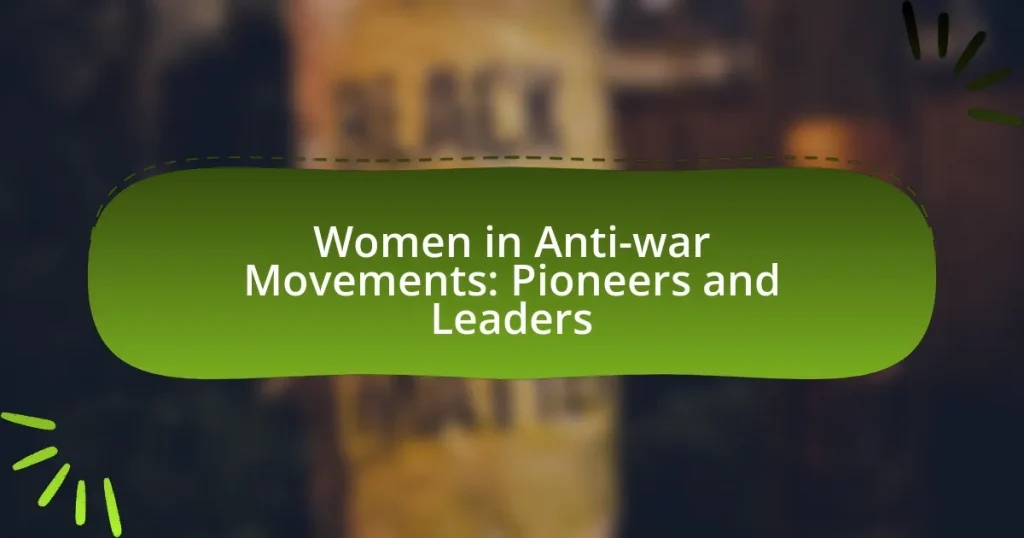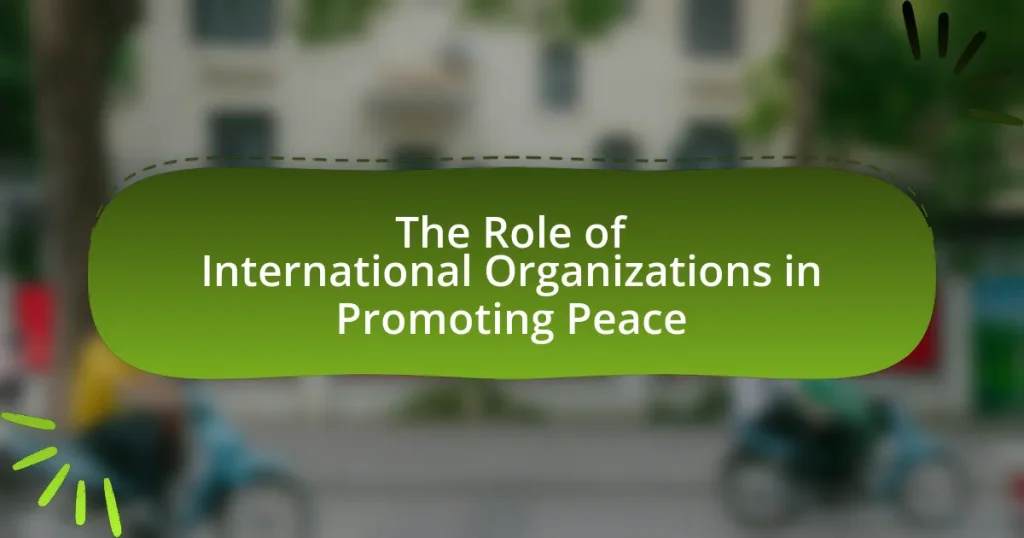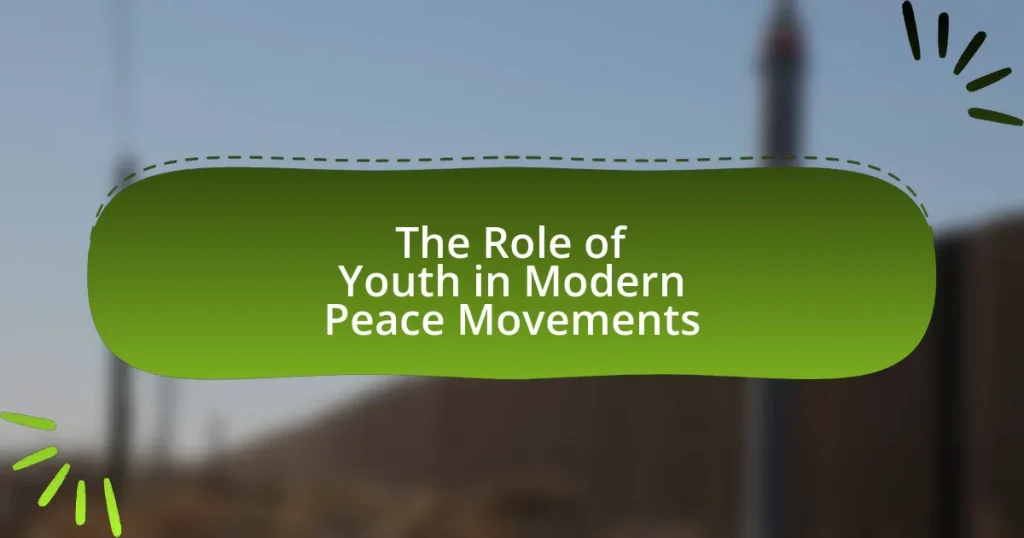The article examines the significant impact of social media on global peace activism, highlighting how platforms like Twitter and Facebook facilitate communication, mobilization, and awareness among activists. It discusses the transformative role of social media in organizing movements such as the Arab Spring and #BlackLivesMatter, emphasizing features like real-time communication and accessibility that enhance the effectiveness of peace initiatives. Additionally, the article addresses challenges such as misinformation and online harassment faced by activists, while exploring strategies for leveraging social media to amplify marginalized voices and foster community engagement in peace efforts.

What is the Impact of Social Media on Global Peace Activism?
Social media significantly enhances global peace activism by facilitating communication, mobilization, and awareness. Platforms like Twitter and Facebook allow activists to share information rapidly, organize events, and connect with a global audience, thereby amplifying their message. For instance, the Arab Spring demonstrated how social media could mobilize protests and spread democratic ideals across multiple countries. Additionally, a study by the Pew Research Center found that 69% of adults in the U.S. believe social media is an effective tool for raising awareness about social issues, including peace initiatives. This indicates that social media not only serves as a platform for dialogue but also plays a crucial role in shaping public opinion and fostering international solidarity among peace activists.
How has social media transformed the landscape of peace activism globally?
Social media has transformed the landscape of peace activism globally by enabling rapid communication, mobilization, and awareness-raising among diverse populations. Platforms like Twitter, Facebook, and Instagram allow activists to share information instantly, organize events, and connect with supporters across geographical boundaries. For instance, the Arab Spring demonstrated how social media facilitated grassroots movements, leading to significant political changes in multiple countries. Additionally, studies indicate that social media campaigns can increase public engagement and support for peace initiatives, as seen in the #BlackLivesMatter movement, which highlighted systemic injustices and mobilized global solidarity. This shift has made peace activism more inclusive and accessible, allowing marginalized voices to be heard and fostering a sense of global community around peace efforts.
What are the key features of social media that facilitate peace activism?
The key features of social media that facilitate peace activism include widespread accessibility, real-time communication, and the ability to mobilize communities. Widespread accessibility allows individuals from diverse backgrounds to engage in peace activism, as platforms like Facebook and Twitter can be accessed globally, enabling voices from various regions to be heard. Real-time communication fosters immediate sharing of information and updates, which is crucial during crises or protests, allowing activists to respond swiftly to events as they unfold. Additionally, social media’s capacity to mobilize communities is evidenced by successful campaigns such as the Arab Spring, where online platforms played a pivotal role in organizing protests and spreading awareness about social injustices. These features collectively enhance the effectiveness and reach of peace activism efforts.
How do different social media platforms contribute to peace movements?
Different social media platforms contribute to peace movements by facilitating communication, mobilizing supporters, and raising awareness about social issues. For instance, platforms like Twitter and Facebook allow activists to share real-time updates, organize events, and connect with a global audience, which enhances the visibility of peace initiatives. Research by the Pew Research Center indicates that 69% of adults in the U.S. use social media, providing a vast network for disseminating information and rallying support for peace-related causes. Additionally, Instagram’s visual storytelling capabilities enable activists to share impactful imagery that resonates emotionally, further engaging users in peace movements. These platforms also serve as spaces for dialogue and collaboration, allowing diverse voices to contribute to discussions on peace and conflict resolution.
Why is social media important for raising awareness in peace activism?
Social media is crucial for raising awareness in peace activism because it enables rapid dissemination of information and mobilizes global audiences. Platforms like Twitter and Facebook allow activists to share messages, organize events, and connect with supporters instantly, reaching millions in a matter of seconds. For instance, the Arab Spring demonstrated how social media facilitated grassroots movements, leading to significant political changes across multiple countries. Additionally, studies show that social media campaigns can increase public engagement and support for peace initiatives, as seen in the #BringBackOurGirls campaign, which raised international awareness about the abduction of Nigerian schoolgirls. This illustrates that social media not only amplifies voices but also fosters community and solidarity among peace activists worldwide.
What role does social media play in educating the public about peace issues?
Social media plays a crucial role in educating the public about peace issues by facilitating the rapid dissemination of information and fostering community engagement. Platforms like Twitter, Facebook, and Instagram enable organizations and activists to share educational content, raise awareness about conflicts, and promote peace initiatives to a global audience. For instance, campaigns such as #PeaceDay and #EndViolence have successfully mobilized users to participate in discussions and events related to peace, demonstrating the effectiveness of social media in amplifying messages. Research indicates that social media can increase public awareness and understanding of peace issues, as seen in studies showing that online engagement correlates with higher levels of knowledge about global conflicts and peace efforts.
How does social media amplify the voices of marginalized communities in peace activism?
Social media amplifies the voices of marginalized communities in peace activism by providing accessible platforms for expression and mobilization. These platforms enable individuals from underrepresented groups to share their narratives, organize events, and connect with broader audiences, thus increasing visibility for their causes. For instance, movements like #BlackLivesMatter and #MeToo have utilized social media to highlight issues of racial and gender injustice, garnering international attention and support. Research indicates that social media campaigns can lead to significant offline actions, such as protests and policy changes, demonstrating the effectiveness of these digital tools in fostering community engagement and advocacy.
What challenges does social media present to global peace activism?
Social media presents significant challenges to global peace activism by facilitating the spread of misinformation and polarizing narratives. Misinformation can undermine the credibility of peace movements, as false information can lead to public distrust and confusion regarding the goals and actions of activists. Additionally, social media algorithms often promote divisive content, which can exacerbate tensions and create echo chambers that hinder constructive dialogue. A study by the Pew Research Center found that 64% of Americans believe that social media has a mostly negative effect on the way things are going in the country, indicating widespread concern about its impact on societal cohesion.
How can misinformation on social media undermine peace efforts?
Misinformation on social media can significantly undermine peace efforts by spreading false narratives that incite violence and distrust among communities. For instance, during the 2016 U.S. presidential election, false information circulated on platforms like Facebook and Twitter, leading to increased polarization and hostility among different political groups. This environment of mistrust can escalate tensions in conflict-prone regions, as seen in the Rohingya crisis in Myanmar, where misinformation fueled ethnic violence and humanitarian crises. Furthermore, studies indicate that misinformation can lead to the misallocation of resources in peacebuilding initiatives, as organizations may focus on addressing fabricated issues rather than real grievances, ultimately hindering effective conflict resolution.
What are the risks of online harassment faced by peace activists on social media?
Peace activists on social media face significant risks of online harassment, including threats, doxxing, and targeted misinformation campaigns. These forms of harassment can lead to psychological distress, reduced participation in activism, and even physical harm. For instance, a study by the Pew Research Center found that 40% of social media users have experienced online harassment, with activists being particularly vulnerable due to their visibility and the controversial nature of their work. Additionally, the Global Network Initiative reported that online harassment can deter individuals from expressing their views, thereby stifling important discussions around peace and social justice.
How do social media campaigns mobilize support for peace initiatives?
Social media campaigns mobilize support for peace initiatives by leveraging their vast reach and ability to engage diverse audiences. These campaigns utilize platforms like Twitter, Facebook, and Instagram to disseminate information, raise awareness, and foster community engagement around peace-related issues. For instance, the #PeaceDay campaign, which promotes the International Day of Peace, has successfully mobilized millions of participants globally, demonstrating how social media can amplify messages and encourage collective action. Additionally, studies show that social media can increase public participation in peace initiatives by providing a space for dialogue and collaboration, as evidenced by the rise of grassroots movements that have gained traction through online platforms.
What strategies are effective in creating viral peace campaigns on social media?
Effective strategies for creating viral peace campaigns on social media include leveraging emotional storytelling, utilizing influential partnerships, and employing targeted hashtags. Emotional storytelling engages audiences by connecting them to personal experiences related to peace, which can increase shares and interactions. Collaborating with influencers or organizations that have a large following amplifies the message and reaches a broader audience, as seen in campaigns like #PeaceDay, which gained traction through partnerships with celebrities. Additionally, targeted hashtags help categorize content, making it easier for users to find and engage with the campaign, as demonstrated by the success of the #NotInMyName campaign, which effectively mobilized support for peace initiatives.
How do hashtags and trends influence participation in peace activism?
Hashtags and trends significantly enhance participation in peace activism by increasing visibility and engagement among diverse audiences. When a hashtag related to peace activism gains traction, it creates a collective identity and mobilizes individuals who may not have been previously involved. For instance, the #BlackLivesMatter movement utilized social media hashtags to raise awareness about racial injustice, leading to widespread protests and discussions about peace and equality. Research indicates that social media campaigns using trending hashtags can lead to a 30% increase in participation rates for related events and initiatives, demonstrating the effectiveness of this strategy in galvanizing support for peace efforts.

What are the case studies of successful social media-driven peace movements?
Successful social media-driven peace movements include the Arab Spring, the #BlackLivesMatter movement, and the #MeToo movement. The Arab Spring, which began in 2010, utilized platforms like Facebook and Twitter to organize protests against authoritarian regimes in Tunisia, Egypt, and Libya, leading to significant political changes. The #BlackLivesMatter movement, initiated in 2013, leveraged social media to raise awareness about racial injustice and police violence, resulting in widespread protests and policy discussions across the United States and globally. The #MeToo movement, which gained momentum in 2017, used social media to empower individuals to share their experiences of sexual harassment and assault, leading to cultural shifts and legislative changes regarding sexual misconduct. Each of these movements demonstrates the power of social media in mobilizing communities, raising awareness, and fostering dialogue around peace and justice issues.
How did social media contribute to the Arab Spring as a peace movement?
Social media significantly contributed to the Arab Spring as a peace movement by facilitating communication, organization, and the dissemination of information among activists. Platforms like Facebook and Twitter enabled individuals to share real-time updates, mobilize protests, and foster a sense of community, which was crucial in countries like Tunisia and Egypt. For instance, the use of social media in Tunisia helped organize mass protests that led to the ousting of President Zine El Abidine Ben Ali in January 2011, demonstrating the power of collective action. Additionally, social media served as a tool for peaceful advocacy, allowing activists to promote non-violent resistance and share messages of solidarity, which helped to frame the uprisings as movements for democracy and human rights rather than violent revolts.
What lessons can be learned from the Arab Spring regarding social media’s role in activism?
The Arab Spring demonstrates that social media can serve as a powerful tool for mobilizing activism and facilitating communication among protesters. During the Arab Spring, platforms like Facebook and Twitter enabled activists to organize protests, share information, and raise awareness on a global scale, leading to significant political changes in countries such as Tunisia and Egypt. For instance, in Tunisia, social media played a crucial role in the coordination of protests against the government, contributing to the ousting of President Zine El Abidine Ben Ali in January 2011. This illustrates that social media can amplify voices, foster solidarity, and challenge authoritarian regimes, highlighting its potential as a catalyst for social and political change.
How did social media facilitate international solidarity during the Arab Spring?
Social media facilitated international solidarity during the Arab Spring by enabling real-time communication and the sharing of information across borders. Platforms like Twitter and Facebook allowed activists to broadcast their struggles, mobilize support, and connect with global audiences, which amplified their messages. For instance, the hashtag #Jan25 became a rallying point for international attention on the Egyptian protests, leading to widespread global demonstrations in solidarity. This interconnectedness not only raised awareness but also fostered a sense of shared purpose among diverse groups advocating for democratic reforms and human rights in the region.
What role did social media play in the Black Lives Matter movement?
Social media played a crucial role in the Black Lives Matter movement by facilitating rapid communication and mobilization among activists. Platforms like Twitter and Facebook enabled the dissemination of information regarding incidents of police violence, allowing for real-time updates and widespread awareness. For instance, the hashtag #BlackLivesMatter became a rallying cry, leading to global protests and discussions about systemic racism. According to a study by the Pew Research Center, 64% of Americans believe social media has been essential for the movement, highlighting its effectiveness in organizing events and fostering community engagement.
How did social media help in organizing protests and raising awareness for racial justice?
Social media significantly aided in organizing protests and raising awareness for racial justice by providing a platform for rapid communication and mobilization. Platforms like Twitter and Facebook allowed activists to share information about events, coordinate logistics, and disseminate messages to a wide audience almost instantaneously. For instance, during the Black Lives Matter movement, hashtags such as #BlackLivesMatter and #SayHerName became rallying points that not only organized protests but also educated the public on systemic racism and police brutality. According to a study published in the journal “Social Media + Society,” social media was instrumental in increasing public engagement and participation in protests, demonstrating its effectiveness as a tool for social change.
What impact did social media have on global conversations about systemic racism?
Social media significantly amplified global conversations about systemic racism by providing a platform for marginalized voices and facilitating widespread awareness. The rapid dissemination of information through platforms like Twitter and Instagram allowed movements such as Black Lives Matter to gain international traction, mobilizing millions to engage in discussions and protests. For instance, the hashtag #BlackLivesMatter was used over 30 million times on Twitter in 2020 alone, illustrating the scale of engagement and the role social media played in shaping public discourse. This connectivity enabled individuals across different countries to share experiences, resources, and strategies, fostering a collective understanding of systemic racism as a global issue rather than a localized concern.
How can social media be leveraged for future peace initiatives?
Social media can be leveraged for future peace initiatives by facilitating communication, mobilizing support, and raising awareness about peace efforts. Platforms like Twitter and Facebook enable activists to share information rapidly, connect with like-minded individuals, and organize events, which can amplify their reach and impact. For instance, the Arab Spring demonstrated how social media was instrumental in mobilizing protests and spreading messages of peace and democracy across multiple countries. Additionally, campaigns such as #PeaceDay have utilized social media to promote global awareness and participation in peace initiatives, showcasing the effectiveness of these platforms in fostering a collective movement towards peace.
What best practices should activists follow when using social media for peace advocacy?
Activists should prioritize authenticity, engagement, and strategic messaging when using social media for peace advocacy. Authenticity builds trust with the audience, as seen in campaigns like #BlackLivesMatter, which effectively utilized personal stories to resonate emotionally. Engagement involves actively responding to followers and fostering dialogue, which enhances community involvement and support. Strategic messaging requires clear, concise, and impactful communication, as demonstrated by the use of infographics and videos that convey complex issues simply and effectively. These practices not only amplify the message but also mobilize support and foster a sense of community among advocates.
How can technology enhance the effectiveness of social media in peace activism?
Technology enhances the effectiveness of social media in peace activism by enabling real-time communication, broadening outreach, and facilitating data-driven strategies. Real-time communication allows activists to mobilize quickly during crises, as seen in the Arab Spring, where social media platforms like Twitter played a crucial role in organizing protests. Broadening outreach occurs through algorithms that connect users with similar interests, increasing the visibility of peace initiatives to a global audience. Additionally, technology provides tools for data analysis, enabling activists to assess the impact of their campaigns and adjust strategies accordingly, as demonstrated by organizations using social media analytics to measure engagement and influence.
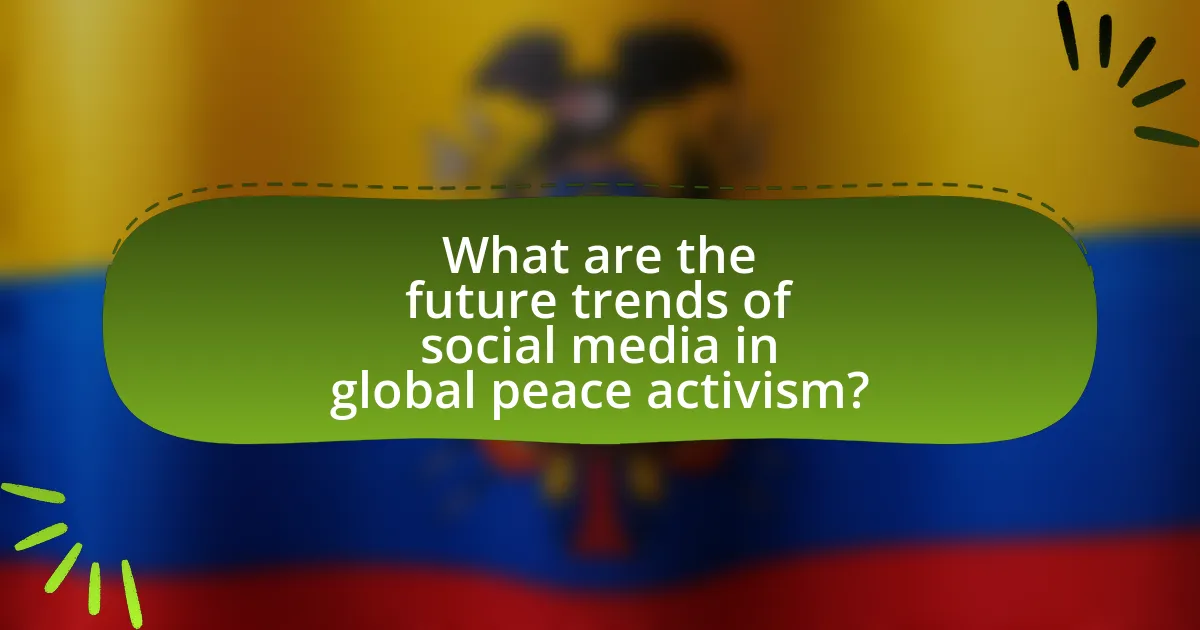
What are the future trends of social media in global peace activism?
Future trends of social media in global peace activism include increased use of artificial intelligence for targeted messaging, enhanced community engagement through interactive platforms, and the rise of decentralized networks to promote grassroots movements. Social media platforms are likely to leverage AI algorithms to analyze user behavior and tailor content that resonates with specific audiences, thereby increasing the effectiveness of peace campaigns. Additionally, interactive features such as live streaming and polls will foster greater participation and dialogue among activists and supporters. The emergence of decentralized networks, such as blockchain-based platforms, will empower local communities to organize and mobilize without reliance on traditional social media giants, ensuring that diverse voices are heard in the global peace discourse. These trends are supported by the growing number of users engaging in social activism online, with a report from the Pew Research Center indicating that 70% of social media users have participated in some form of activism through these platforms.
How is the evolution of technology shaping the future of peace activism on social media?
The evolution of technology is significantly shaping the future of peace activism on social media by enhancing communication, mobilization, and awareness. Advanced platforms enable activists to reach global audiences instantly, facilitating the rapid dissemination of information regarding peace initiatives and conflicts. For instance, the use of hashtags like #BlackLivesMatter and #MeToo has mobilized millions, demonstrating how technology can amplify voices and foster community engagement. Additionally, tools such as live streaming and video sharing allow activists to document events in real-time, increasing transparency and accountability. According to a study by the Pew Research Center, 69% of adults in the U.S. use social media, which underscores the potential for these platforms to influence public opinion and drive social change. Thus, the integration of evolving technologies into social media is transforming how peace activism is conducted, making it more accessible and impactful.
What emerging platforms could influence peace activism in the coming years?
Emerging platforms such as TikTok, Clubhouse, and decentralized social networks like Mastodon could significantly influence peace activism in the coming years. TikTok’s short-form video format allows for rapid dissemination of messages and engagement with younger audiences, making it a powerful tool for raising awareness about peace initiatives. Clubhouse, with its audio-based discussions, fosters real-time dialogue and community building around peace topics, enabling activists to connect and collaborate effectively. Additionally, decentralized platforms like Mastodon promote free speech and reduce censorship, allowing activists to share their messages without the constraints often found on mainstream social media. These platforms are increasingly being utilized for grassroots movements, as evidenced by the rise of viral campaigns and community-driven initiatives that have gained traction in recent years.
How can artificial intelligence be utilized to support peace movements on social media?
Artificial intelligence can be utilized to support peace movements on social media by analyzing large volumes of data to identify trends, sentiments, and influential voices within peace activism. AI algorithms can monitor social media platforms for hate speech, misinformation, and violent rhetoric, allowing organizations to respond swiftly and effectively. For instance, AI-driven sentiment analysis tools can gauge public opinion on peace initiatives, enabling activists to tailor their messaging for greater impact. Additionally, machine learning models can help in identifying key influencers and networks that promote peace, facilitating targeted outreach and collaboration. Studies have shown that AI can enhance engagement by optimizing content delivery based on user preferences, thereby increasing the visibility of peace movements.
What are the implications of social media regulation for peace activism?
Social media regulation can significantly hinder peace activism by limiting the ability of activists to communicate and organize effectively. Restrictions on content can lead to censorship of peaceful protests and discussions, reducing visibility for critical issues. For instance, in countries with stringent social media laws, activists have reported decreased engagement and outreach, as seen during the Arab Spring, where social media was pivotal for mobilization. Furthermore, regulations may disproportionately affect marginalized voices, stifling diverse perspectives essential for comprehensive peace dialogues.
How might changes in social media policies affect the freedom of expression for activists?
Changes in social media policies can significantly restrict the freedom of expression for activists by imposing stricter content moderation and censorship. For instance, platforms may implement algorithms that prioritize certain types of content while suppressing dissenting voices, which can lead to the silencing of activist messages. A notable example is the 2020 policy changes by Facebook, which increased the removal of posts deemed to violate community standards, disproportionately affecting political activism. Additionally, the introduction of regulations that require user identification can deter activists from expressing their views due to fear of repercussions, as seen in various countries where online dissent has led to legal action against individuals. These changes can create an environment where activists feel less safe to communicate their ideas, ultimately undermining their ability to mobilize and advocate for social change.
What role do governments play in regulating social media’s impact on peace activism?
Governments play a crucial role in regulating social media’s impact on peace activism by establishing laws and guidelines that govern online speech and content moderation. These regulations can either support or hinder peace activism, depending on how they are implemented. For instance, governments may enact policies to prevent hate speech and misinformation, which can create a safer online environment for peace activists to organize and communicate. Conversely, excessive regulation or censorship can stifle free expression and limit the ability of activists to mobilize support. Evidence of this can be seen in various countries where governments have imposed restrictions on social media platforms, impacting the effectiveness of peace movements, such as during the Arab Spring, where social media was pivotal for organizing protests but faced government crackdowns.
What practical tips can activists use to maximize their impact on social media?
Activists can maximize their impact on social media by creating engaging, shareable content that resonates with their audience. This involves using compelling visuals, storytelling techniques, and clear calls to action to encourage participation and sharing. Research indicates that posts with images receive 94% more views than those without, highlighting the importance of visual content in capturing attention. Additionally, utilizing relevant hashtags can increase visibility, as posts with at least one hashtag can see a 12.6% increase in engagement compared to those without. Engaging with followers through comments and direct messages fosters community and encourages further sharing of content.
How can activists effectively engage their audience on social media platforms?
Activists can effectively engage their audience on social media platforms by utilizing targeted messaging, interactive content, and community building. Targeted messaging involves crafting clear, concise, and relatable posts that resonate with the audience’s values and concerns, which can increase engagement rates. Interactive content, such as polls, live Q&A sessions, and challenges, encourages participation and fosters a sense of belonging among followers. Community building is essential; creating spaces for dialogue and support can enhance loyalty and motivate followers to take action. Research indicates that posts with visual elements, such as images and videos, receive 94% more views than text-only posts, highlighting the importance of engaging formats in capturing attention and driving interaction.
What tools and resources are available to support peace activism on social media?
Various tools and resources support peace activism on social media, including platforms like Twitter, Facebook, and Instagram, which facilitate the dissemination of information and mobilization of supporters. Additionally, organizations such as Peace Direct and the United Nations provide resources like toolkits, guides, and training programs specifically designed for online activism. Research indicates that social media campaigns can significantly increase awareness and engagement; for instance, the #BlackLivesMatter movement utilized Twitter to amplify its message, demonstrating the effectiveness of social media in rallying support for peace initiatives.
